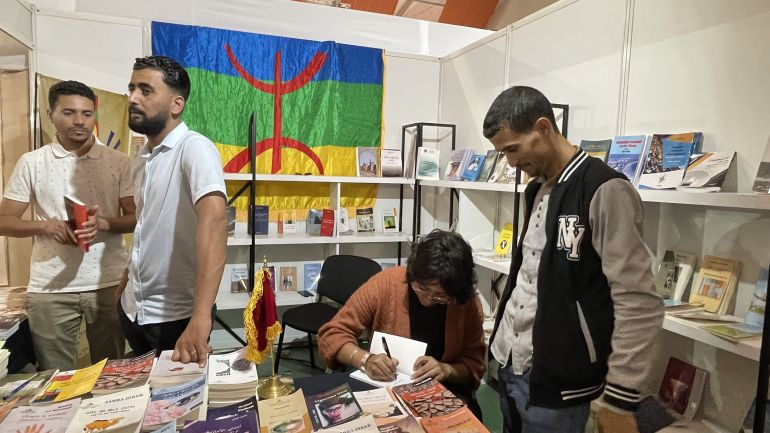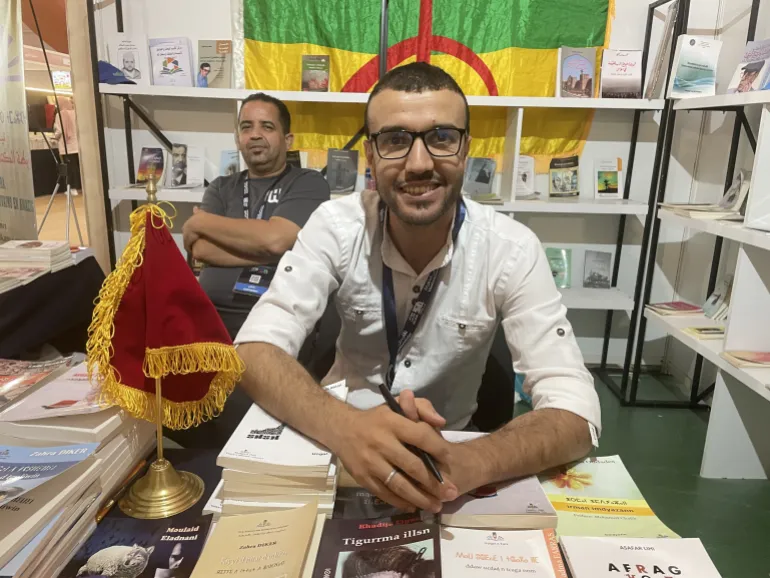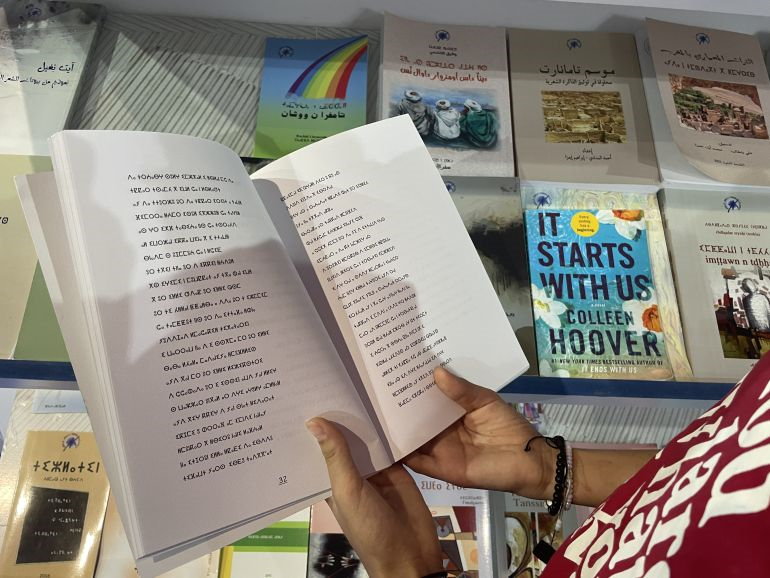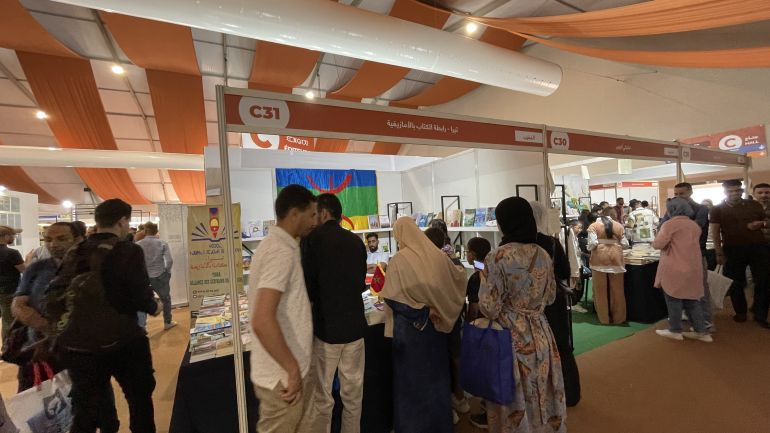Moroccan literature written in Amazigh...narrative momentum and promising prospects

Literary productions in the Amazigh language issued by the Terra Association for Writers in Amazigh
Obstacles and problems did not prevent the flourishing of writing in the Amazigh language and the succession of literary publications that strengthened the Moroccan library in various genres thanks to enthusiastic and creative youth who brought about a creative revolution in Moroccan Amazigh literary production.
A few days ago, the Moroccan writer Fadema Firas signed her novel “Telvigen” or “The Boil,” published in the Amazigh language, in the gallery of the Terra Association of Writers in Amazigh at the International Publishing and Book Fair, which was held in Rabat in the first half of this month of June.
Fadhima began her creative experience in 2014 with a novel titled “Under the Throne of Misery,” which won the Writers’ Association Competition in Amazigh. In 2018, her novel (Aaskoti n Talkaut), meaning “The Handle of the Mill of Oppression,” won the Moroccan Book Award, which was awarded for the first time to a literary production in the Amazigh language. .

Writer Fadima Firas signs her novels at the International Publishing and Book Fair in Rabat
In her novels, Fadema addresses various topics about the lack of equality between men and women and the oppression that people suffer from, and she draws from the source of the Amazigh myth to build a narrative that combines reality and imagination.
In turn, the young novelist and storyteller Hisham Fouad Kugelt signed his new short story collection, “They Said People of the Future,” within the activities of the International Book Fair. Hisham, a professor of the Amazigh language, began his narrative path in 2016 after the Tira Book Association in Amazigh published his first short story collection (Ajdar Yadfuton), meaning “The Burning.” “The Delicious”, three years later he published a collection of short stories and then a novel entitled “A Hook and a Bait”, in which he dealt with the issue of internal and external migration and its social motives. In 2021, he published a detective novel for which he won the National Prize for Amazigh Culture , awarded by the Royal Institute for Amazigh Culture .
The narrative texts of these two young novelists, along with others, revolutionized Moroccan literature written in Amazigh, as they succeeded in transcending the traditional style of Amazigh literary expression and opened up to new expressive, creative, and aesthetic styles that respond to the transformations that literature in general knows.
Hisham told Al Jazeera Net that Moroccan literature written in the Amazigh language went through three basic stages. In the first, founding stage, the pioneers of the Amazigh movement, such as Muhammad Mustawi, Al-Moumen Ali, Ali Yakan, and others, worked to produce stories, novels, and poetry collections from a militant standpoint and their desire to leave a literary legacy for new generations, and it began The second stage, from the end of the 1990s to 2012, was when a new form of literature crystallized and moved from traditional themes such as identity, language, and land to the stage of diversifying topics and openness to global literatures of all races.

The young storyteller and novelist Hisham Fouad Coglett at the International Publishing and Book Fair in Rabat
As for the third stage, which is the stage of expansion and development from 2012 to today, it was characterized by the emergence of the detective novel, fantasy, and historical and mythological novels, according to the Moroccan novelist and storyteller.
From the beginnings to today
The beginning of the modern and contemporary Amazigh literary book was with the publication of the first poetry collection in 1976, entitled (Iskraf), meaning “Shackles,” by Mohamed Mestawi, according to what was explained to Al Jazeera Net by Mohamed Aqir, a professor in the Department of Amazigh Studies at Ibn Zohr University in Agadir.
The story did not appear in the form of a printed and published collection until the late 1980s, with the publication of the first collection, “Imarain” (Lovers), by Hassan Ed Belkacem in 1988.
As for the novel in Amazigh, we can talk about its writing starting with the text (Askif n Injadhan) (Poetry Soup) by Ali Ikin, which was published in 1994 in the magazine “Tifawt” and then published in print in 2004 as part of the publications of the Royal Institute of Amazigh Culture, while the first theatrical text was printed in 1983. Titled (Asan Samidanin) “Cold Days” by Al-Safi Moumin Ali.

Publications of the Royal Institute of Amazigh Culture
Afqir points out that the total outcome of Amazigh literary creativity in Morocco amounted to about 650 creative works, including 350 poetry collections, 150 short story collections, 110 novels, and 40 theatrical scripts.
According to the researcher, the most important share of this tally was published in the years of the third millennium, with a total of 606 literary works: 315 in poetry, 143 short story collections, 109 novels, and 39 theatrical scripts.
Muhammad Aqir attributes this development in literary productions in the Amazigh language to the new reality of the Amazigh language in Morocco after its official recognition and the subsequent measures that contributed directly or indirectly to the development of Amazigh literary creativity, including the establishment of the Royal Institute for Amazigh Culture, the integration of Amazigh into part of primary education, and the establishment of Bachelor's and Master's courses for Amazigh studies in some colleges, in addition to establishing groups that bring together Amazigh writers in the form of a regional writers' union, organizing competitions for literary creativity and awarding prizes to the winners.
Active civil society
Civil society is active alongside official bodies in supporting the publication of Amazigh books. Among the publishing associations there is the Terra Association of Writers in Amazigh in Agadir, the Moroccan Association for Research and Cultural Exchange, the Tamaynot Association, and in the countryside the Ait Said Association for Culture and Development, and the Massinissa Association. As for the official institutions concerned with publishing We find the Royal Institute of Amazigh Culture and the Ministry of Culture.

The gallery of the Terra Association of Writers in Amazigh at the International Publishing and Book Fair in Rabat
Lahcen Zohour, head of the Tira Association of Amazigh Writers, believes that the development of Moroccan literature written in Amazigh is linked to the development of the Amazigh cultural movement in the Kingdom and also to the cultural and political atmosphere that followed the recognition of the Amazigh language and the establishment of the Royal Institute for Amazigh Culture.
He pointed out in an interview with Al Jazeera Net that Moroccan writers and writers who write in Amazigh began during that stage to think about bringing together creative people to encourage Amazigh literary production in accordance with known literary standards and organize the publishing and distribution process, after writers were publishing their creative works based on their individual efforts.
In this context, the Terra Association of Writers in the Amazigh Language was established, and it worked to develop a number of programs, such as announcing the Amazigh Creativity Award, organizing annual meetings that bring together creative men and women, and training young people on the techniques of writing stories and theater under the supervision of senior writers who have experience and then publishing their literary productions. .
Since its founding in 2009 until now, the Terra Association has published 240 literary works (in addition to 14 issues still in print) in various types of modern literature.
After literature written in Amazigh was limited and marginalized, says Lahcen Zohour, today, thanks to the abundance of production and publication, it has established itself as an essential component of Moroccan literature.
Issues and obstacles
The identity obsession and legal demands dominated the first literary publications of Amazigh creators, according to what Aisha Walzine, a researcher in written Amazigh literature and the “staff” at the Royal Institute of Amazigh Culture, explained to Al Jazeera Net. However, in an interview with Al Jazeera Net, she pointed out that the development witnessed by Amazigh literature was accompanied by a transformation. In the preoccupations of writers and writers, interest in the aesthetic obsession and artistic vision has become more strongly present.
Amazigh literature faces the same obstacles that literature in general faces, mainly related to reading rates and competition with technology, according to Mohamed Afkir.
However, he points out problems related to this literary production, which relate to the failure to generalize the teaching of the Amazigh language in all levels of education, especially secondary and university, which makes the audience for Amazigh literature limited to speakers of this language among Moroccans.
Before starting to write, the writer faces various problems and is asked a number of questions and is required to answer them first, according to researcher Aisha Wal-Zein, and among these questions is: In what language will I write? Will I write in the common language used daily and improve it? Or write in standard language? Do I write in my Sussian, Tamazight, or Tarifit dialect? Or do I combine them, create new words, or borrow from the Arabic language? Then he soon faces other questions related to the letter of writing. There are those who prefer to write with the Latin letter, some prefer the Arabic letter, and others with the Tifinagh letter.
However, these obstacles and problems did not inhibit the flourishing of writing in the Amazigh language and the succession of literary publications that strengthened the Moroccan library in various genres thanks to enthusiastic and creative youth who brought about a creative revolution in Moroccan Amazigh literary production.
Source : Al Jazeera

